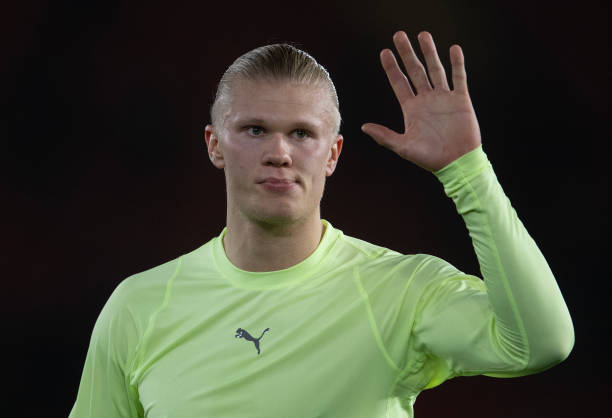Before last week, Erling Haaland’s longest goal drought at Manchester City stood at one game.
Haaland’s 27 goals to date have come in 16 games, with only five goalless games before the turn of the year – one being in the Community Shield and another in the 45 minutes he played against Borussia Dortmund before going off with an injury.
In the last three City games, though, Haaland has started twice and come off the bench for half an hour in the other – but failed to register a single shot on target across his last 215 minutes. It’s a spell that has caused Pep Guardiola concern, and could have a number of causes.
One theory could be that Haaland’s lack of action during the World Cup means he will take longer to get back up to speed, or maybe his injury in the Autumn is still not fully healed – although it should be stressed there’s been no word from City or Haaland whether that is the case.
More likely is that after 20 or so games, opposition defences have finally figured out a way to stop Haaland from being as devastatingly effective.
After scoring in 11 of his first 12 competitive games for City, his prolificacy was never going to maintain at that level, especially with the fixture list increasing in demand and injuries taking hold. Since drawing a blank in that 13th game at Liverpool, Haaland has seven goals in ten – which is only considered a slow return given his 20 goals beforehand.
Yet even when Haaland was scoring for fun, defenders and opposition managers were slowly working out how to stop him, even if they accepted that he is almost impossible to stop if he is allowed to attack a ball in the area.
Some sides have given him the physical treatment, with Brentford and Everton, in particular, succeeding by putting a big defender on him from the first minute.
Others have, fairly, accepted that their defenders cannot compete with his movement in and around the box, so focussed their attentions on stopping the ball from reaching him in those situations. Brentford again succeeded in pressing City well and taking key players like Kevin De Bruyne out of the game.
Their theory was that if they can stop City from getting the ball out wide to put a cross in, and crowd the areas in the centre of the pitch, then Haaland would have limited service and therefore be easier to stop scoring.
Manchester United pulled off that tactic perfectly in Saturday’s derby, by man-marking City’s midfield three, closing down their wingers quickly, and restricting Haaland to just 20 touches in 90 minutes.
Haaland resorted to coming short alongside Rodri to lay the ball off and attempt to run in the space he’d left behind, but with United’s press so well drilled, they would close down the passer and ensure the pass couldn’t be played.
Likewise at Southampton in the Carabao Cup, their boss Nathan Jones explained how he pushed James Ward-Prowse high to ensure Kalvin Phillips was given no time on the ball, disrupting City’s build-up and stopping them from getting the ball forward – a tactic that continued to be successful after Haaland was called for from the bench.
Maybe Haaland and City have simply given their opponents a 20-game head-start before an effective plan has been found to stop him.
Guardiola said at Old Trafford that City’s fellow attackers must do more to find Haaland in the box. Whether that’s move the ball quicker to beat a high press, to therefore get the ball wide and cross for Haaland to attack, or whether a plan needs to be devised to vary Haaland’s supply a little more. It’s clear that Guardiola feels that Haaland’s relatively long drought of two-and-a-bit games without a goal is not just the striker’s fault.
But with any change in approach, Haaland will need to be on board as well. So it’s encouraging to hear him discuss his goal targets for the season in a recent promotional video.
Asked about whether he has set any number of goals he wants to score for City, Haaland gave a more collective answer, insisting he is committed to working as part of a unit to finish off his teammates’ attacks, rather than focus on goals as an individual achievement.
“I don’t set any targets that I think of,” he said. “I try to do all the things on the pitch and to of course play good with the team. And then when we play good as a team then the chances will come for everyone.
“Me as a striker, my job is to put the ball in the back of the net so of course I should score goals but it’s not the main thing I think of. You have to think of playing good to do things right.”
If City need to find a Plan B to get Haaland scoring again, he knows he must play a part too, not just his teammates.
